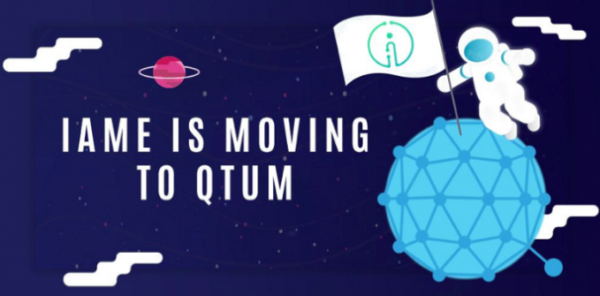One of the true indicators of a blockchain platform’s value is whether or not people have actually decided to build on it. So it comes as little surprise that Qtum is keen to broadcast the news that identity startup IAME has selected their platform over Ethereum.
In the official announcement, Qtum used marriage as an analogy to describe the levels of trust, love, and hope required for a blockchain company to commit its future to one particular platform.
This is a big step for IAME and a bullish piece of news for Qtum which we’ll dissect a bit below. But, first, what exactly is IAME? Why did they decide to build on Qtum? How does this help Qtum? And why does any of it mater?

What is IAME?
IAME is a decentralized identification framework that has 2 primary aims:
- allow cryptocurrency users to verify each other’s identities without having to disclose non-essential confidential information
- make sure that users are not unwittingly involved in some illicit or illegal activity
IAME’s framework works to protect people’s identities through a system that uses fragmented data and consensus identification, all controlled by a Qtum-powered dapp.
They’ve produced a great video explainer which can be viewed here, or if you’d like more depth, check out their whitepaper.
From the technology conceptualization last October to the fundraising efforts in January (and ongoing) to the prototyping and proof of concept work in Q2 2018, IAME has covered a lot of ground. But it’s this announcement that signals the start of the next development chapter, and it begs the question…
Why is IAME Building on QTUM?
In general terms, both Ethereum and QTUM have the smart contract capacity to handle the requirements of IAME’s framework. But if you add mobile devices into the equation, this is where QTUM starts to pull ahead.
IAME themselves outlined 3 key reasons for the switch: these are transaction handling, QTUM X86 VM, and a proven PoS system. Let’s break each of these down a bit further.
If you want to run a full node as part of your smart contract process, this can mean downloading the entire blockchain, which is generally not a feasible option on mobile devices. This is where QTUM’s advantages over Ethereum really start to crystallize.
To use their words:
QTUM uses UTXO that can utilize the simple payment verification (SPV) protocol. The SPV protocol operates with light clients that can be used on mobile devices to verify transactions without needing to run a full node.
This means that a user can execute a smart contract from their phone without exhausting its storage capacity or having to be in sync with the latest blocks.

There is also the ever-present issue of scalability.
Which blockchain platform has the best solution in this sense remains open to debate, but IAME, for one, is betting on Qtum. Qtum operates segwit with 2mb block size and a block time of roughly 2 minutes. This means that as things stand, Qtum handles about 70 tx/s “on chain.” Future plans are in place for trustless off-chain channels, which are intended to drastically expand this number to around 20,000 tx/s.
Also, with the all-important Qtum x86 Virtual Machine (smart contract operating software) on the horizon, IAME (and others) will be able to enjoy dapp development beyond the confines of Solidity.
Lastly, Qtum runs on a Proof-of-Stake system that is far less energy-intensive than its Proof-of-Work counterparts. Ethereum has long been working on a move away from PoW to a version of PoS, but for the moment the edge is Qtum’s. As their blog put it, “save the environment by staking instead of mining!”
How Does IAME Benefit QTUM?
Besides the simple public demonstration of their belief in Qtum, IAME brings quite a bit more to the table. Given that it’s an identity framework, IAME is not only tackling the issues of know your client (KYC) policy, but working to counter money laundering (AML) and counter-terrorism financing (CFF).
Issues associated with KYC and AML are barriers to more adoption of crypto as a whole. Having IAME on board will help “bridge QTUM into the regulated world.”
An example of this could be a bank opening Qtum accounts on behalf of their clients. Furthermore, if it’s easier to identify ownership of digital assets, the continued integration of crypto into the “regular” economy can proceed more quickly – which will benefit not only Qtum, but essentially all crypto projects.
Despite some progress, cryptocurrency hasn’t totally shed its “Bitcoin is for criminals” reputation of the early days. There are a lot of bad actors in the space, tons of scams, and many people using it in an effort to avoid law enforcement. IAME can help in this regard, and another thing it brings to the table is transaction analysis tools. These include things like link analysis and multi-dimensional analysis, both of which are said to be able to help with the detection of suspicious activity and isolate potentially nefarious users.
Final Thoughts
Any fan of QTUM will welcome the news of a project deciding to build on it based on its technical merits. As the technology continues to be developed, these are the types of announcements Qtum needs to gather momentum.
IAME, on the other hand, is still in the pre-ICO phase with a lot of work left to be done in terms of proving itself. If you’re an IAM holder and wondering what all this all means, the team has announced plans to release an updated version of the mobile app with QTUM and QRC20 support.
To learn more about the move, you can read the IAME team’s full FAQ. You can also visit their website to learn more about the project.
Related: 7 QTUM Projects To Get Excited About

